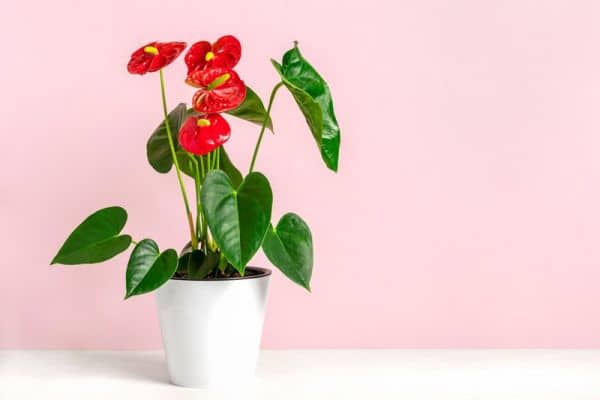Anthurium is a beautiful indoor flowering plant that has more than 1000 species and is native to tropical America. They are just like orchids and bromeliads. So today in this section we will learn all about Anthurium guide to growth and its varieties:
Anthurium Growing
Anthurium may look like a high-maintenance plant but it’s easy to grow in your house. Here are some of the lists you can do to grow anthurium in your house:
- You will need to mix 50-50 of orchid and houseplant potting media to make it well-draining.
- Then plant the anthurium sapling in the container mixture of orchid and houseplant potting media.
- Keep the plant near the east-facing window where they can get plenty of bright but indirect light.
- As they love humidity don’t forget to place them in a humid place like a bathroom.
- Water them properly but don’t get them wet or boggy.
| Mature Size | 12-18 in. tall, 9- to 12-inch wide |
| Sun Exposure | Partial |
| Soil Type | Well-drained |
| Soil pH | Acidic |
| Bloom Time | Spring, summer, fall, winter |
| Flower Color | Red, pink, white |
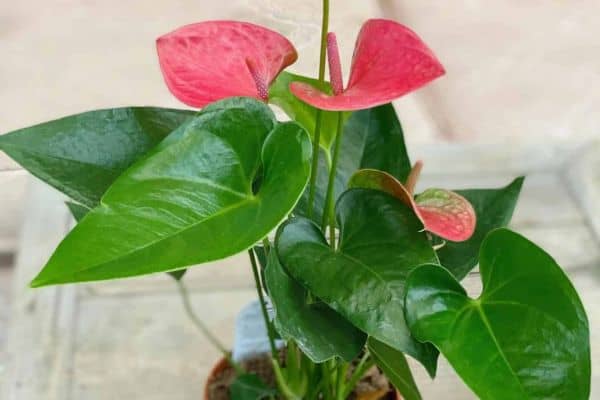
Anthurium Care
Anthurium may look like a high-maintenance plant but it’s easy to take care of in your house. Here are some of the lists you can do to take care of your beautiful anthurium in your house:
Light
Anthurium prefers plenty of bright light but doesn’t keep them in direct sun as that can scorch the leaves. Direct light may also cause your plant to grow poorly and bloom a few flowers so giving them six hours of indirect light is perfect for their growth.
Soil
Anthuriums need well-draining soil so you can make it in your house by mixing 50-50 of orchid and houseplant potting media. They also love Mosses and cocoa coir for their root.
Water
If you have planted anthuriums indoors they need to be watered about once a week with slightly moist but don’t allow the soil to dry. Or you can simply check the top of the soil if it’s dry you can water if no need to be watered.
But if you have planted anthuriums outdoors then you will have to water them every two to three days. But remember not to keep them sitting in water otherwise the root will rot.
Temperature and Humidity
Anthuriums mostly prefer 65 and 85 degrees Fahrenheit for them to grow properly. They won’t grow properly if the temperature is below 60 degrees Fahrenheit and can even not survive if the temperature is below 40 degrees Fahrenheit.
As for humidity, they love humid places so remember to run a humidifier when the dry season starts.
Fertilizer
Anthuriums require high phosphorus liquid fertilizer when they are in their growing stage and need a mixture of water to 1/4 strength and feed every week.
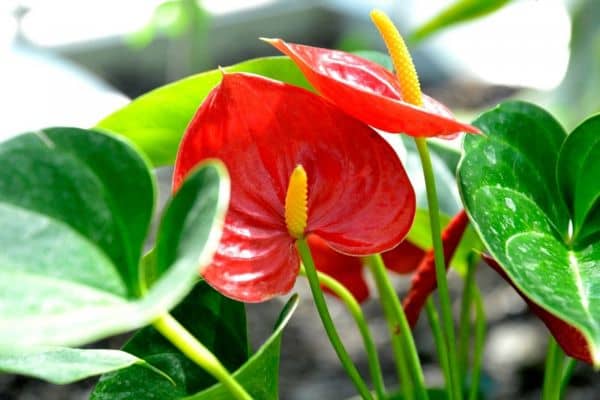
Types of Anthurium
1. Anthurium clarinervium
Anthurium clarinervium which has heart-shaped, dark green leaves that display a beautiful white vein pattern also known as the heart leaf plant. Anthurium clarinervium also looks similar to Anthurium crystallinum and can be distinguished only by there fruits on their flower.
2. Anthurium crystallinum
Anthurium crystallinum which is similar to Anthurium clarinervium has heart-shaped, dark green leaves and a striking white vein pattern. Anthurium crystallinum and Anthurium clarinervium can be distinguished only by the fruits on their flower. Their heart-shaped leaves have purple tinge leaves but later turn green as they grow.
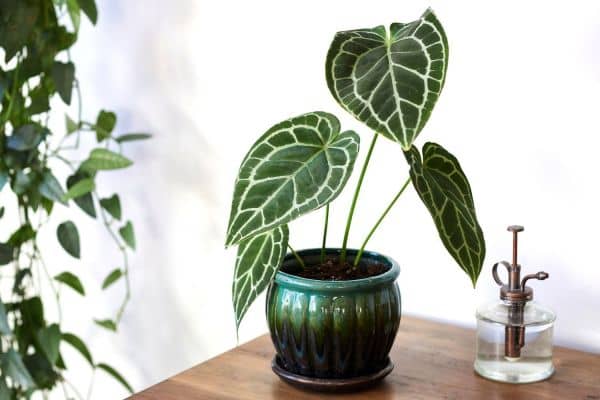
3. Anthurium warocqueanum
Anthurium warocqueanum also known as Queen anthurium this species looks like Anthurium crystallinum. Warocqueanum also has subtle flowers with lance-shaped, dark green leaves and eye-catching white vein patterns. This species is known as Queen anthurium as its lance-shaped leaves can grow up to two meters in size.
4. Anthurium magnificum
Anthurium magnificum is a mix and looks alike to Anthurium crystallinum and Anthurium clarienrvium. But magnificum is a bit smaller than crystallinum and clarienrvium while magnificum also needs support to grow up against.
5. Anthurium veitchii
Anthurium veitchii also known as king anthurium like Anthurium warocqueanum can grow very large leaves with lanceolate in shape, but display ridges instead of a white vein pattern. Veitchii also loves to be in warm places with humid climates.
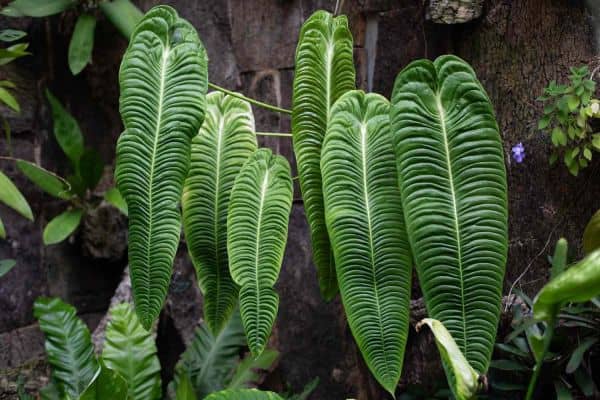
6. Anthurium luxuriant
Anthurium luxuriant which has heart-shaped, leathery leaves has deep ridges that make it look like the surface of a diamond. Their leaves are very dark red or purple but as older they get they change from dark red to dark green at the end of short stems.
7. Anthurium vittarifolium
Anthurium vittarifolium is a beautiful species that hangs long, green leaves-like tails and can be a great plant for hanging baskets. It can also grow on other plants so it is also an epiphyte.
FAQs
Q. Is Anthurium a Good Indoor Plant?
Yes, anthurium is a perfect indoor plant just remember to water them and keep it in a humid place with no direct sunlight.
Q. How Long Do Anthuriums Last?
Anthurium plants last for three to four years and bloom flowers year-round, with each bloom lasting between two and three months
Q. What is Special About Anthurium?
The special thing about anthurium is they have attractive foliage, easy to grow, and can produce flowers all year if a proper environment is provided.
Also Read: Expert Tips: How to Shrink Clothes for a Tailored Fit, According To Laundry Specialists
